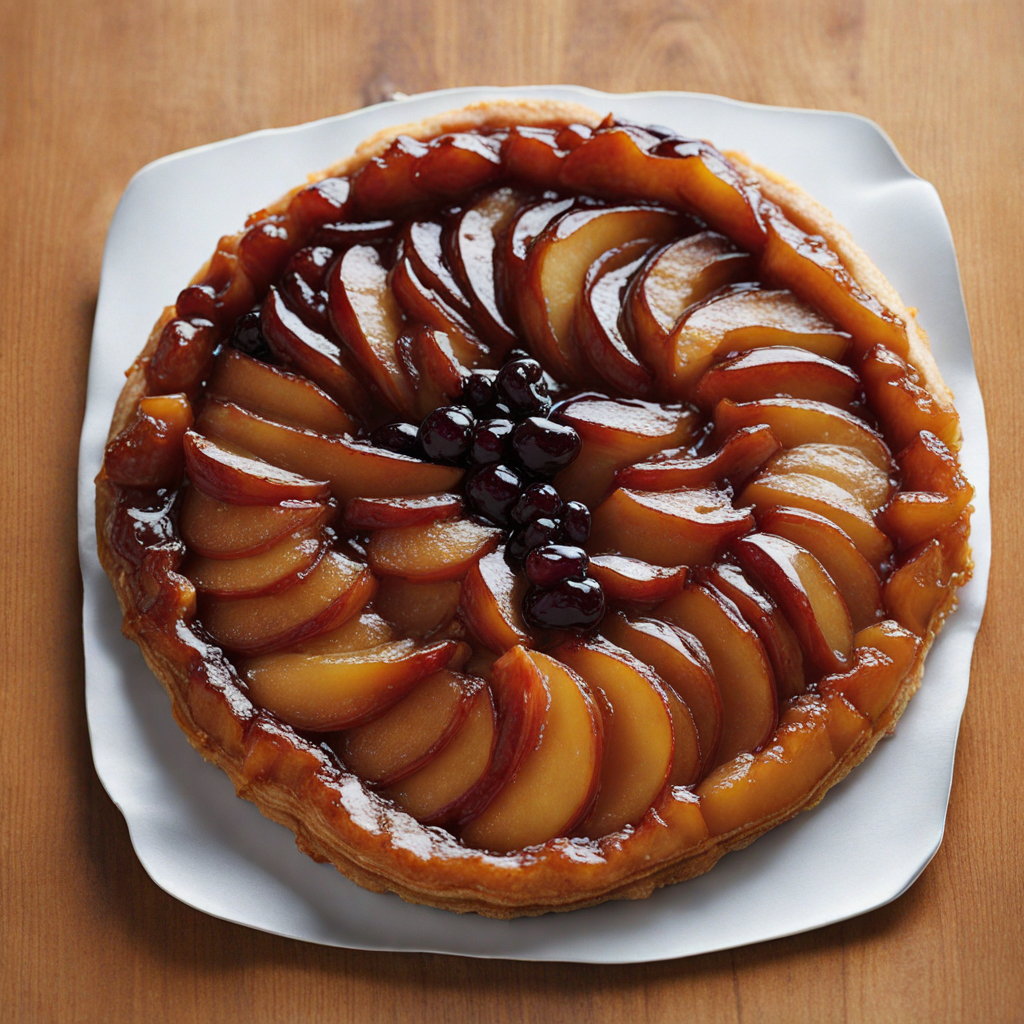Tarte Tatin
Tarte Tatin is a delightful French dessert that perfectly embodies the art of balancing sweet and savory flavors. Originating from the Loire Valley, this upside-down caramelized apple tart is a staple of French patisserie. It features a buttery, flaky pastry crust that cradles juicy, tender apples—usually Granny Smith or Golden Delicious—that are caramelized in a rich mixture of butter and sugar. The process of cooking the apples in the caramel before baking creates an irresistible depth of flavor, where the sweetness of the apples is beautifully enhanced by the rich, nutty notes of the caramel. What sets Tarte Tatin apart is not just its unique preparation but also the textural contrast it offers. The golden-brown pastry is crisp and flaky, providing a satisfying crunch that complements the soft, syrupy apples beneath. Each slice reveals a stunning display of glistening caramel-coated apples, making it as visually appealing as it is delicious. Traditionally served warm, it is often accompanied by a dollop of crème fraîche or a scoop of vanilla ice cream, which adds a creamy richness that balances the tartness of the apples and the sweetness of the caramel. Enjoying Tarte Tatin is a sensory experience that transports you to a French bistro with every bite. The aroma of caramelized apples fills the air, inviting you to indulge in this comforting dessert. Whether you're enjoying it at a quaint café in Paris or attempting to replicate the recipe in your own kitchen, Tarte Tatin is a decadent treat that showcases the simplicity and elegance of French cuisine, making it a must-try for any food lover looking to discover new flavors.
How It Became This Dish
The Tarte Tatin: A Sweet Slice of French Culinary History The Tarte Tatin, an iconic French dessert, is a perfect representation of the unexpected magic that can arise in the kitchen. This caramelized apple tart, which is baked upside down, has a fascinating history steeped in both culinary innovation and serendipitous mishaps. Its origins trace back to the late 19th century in the picturesque region of Sologne, France, particularly in the small town of Lamotte-Beuvron. The dessert is named after the Tatin sisters, Stéphanie and Caroline, who managed the Hôtel Tatin, a modest establishment that became a culinary landmark. Origins of the Tarte Tatin The story of Tarte Tatin is often recounted as a tale of accident and ingenuity. According to popular accounts, the dessert was created by Stéphanie Tatin in the late 1880s. The tale goes that one day, while preparing a traditional apple pie, Stéphanie became distracted and overcooked the apples in butter and sugar. Realizing her mistake, she attempted to salvage the dish by covering the caramelized apples with the pastry dough and baking it in the oven. Once cooked, she flipped the tart over, revealing a beautifully caramelized apple topping. Patrons at the Hôtel Tatin were enchanted by the dish, and it quickly gained popularity, transforming from a happy accident into a beloved classic. The Tatin sisters’ hotel became a hub for travelers, including those from Paris, who visited to experience the charm of the French countryside and, of course, to taste the legendary dessert. The Tarte Tatin soon attracted attention from culinary enthusiasts and chefs alike, solidifying its place in the canon of French cuisine. Cultural Significance The Tarte Tatin is more than just a dessert; it embodies the spirit of French cooking—resourcefulness, creativity, and a deep appreciation for the quality of ingredients. Its rustic nature reflects the ethos of traditional French cooking, where homey and comfort foods hold a special place in the hearts of both locals and visitors. The tart is often associated with the region of Sologne, and its popularity has made it a symbol of French culinary heritage. As the Tarte Tatin gained notoriety, it transcended its humble origins and became a staple in French patisseries and bistros. It is often served warm, accompanied by a dollop of crème fraîche or a scoop of vanilla ice cream, allowing the rich flavors of the caramelized apples to shine. This combination of textures and tastes has made it a perennial favorite among dessert lovers. The Tarte Tatin's charm lies in its simplicity and versatility. While apples are the traditional filling, variations using pears, peaches, and even savory ingredients like tomatoes have emerged. This adaptability speaks to the evolution of the dish over time, allowing chefs to experiment and reinterpret the classic while still honoring its origins. Development Over Time Since its inception, the Tarte Tatin has undergone various transformations, adapting to the changing preferences of diners and the evolving landscape of French cuisine. By the early 20th century, the tart had made its way to Paris, where it was embraced by the culinary elite. Chefs began to experiment with different apple varieties, seeking the perfect balance of sweetness and tartness. The use of Granny Smith and Golden Delicious apples became popular, each contributing its unique flavor profile to the dish. The Tarte Tatin also found its way into cookbooks and culinary literature, further cementing its status as a classic French dessert. Renowned chefs, such as Julia Child and Pierre Hermé, have included their interpretations of the tart in their recipes, introducing the dish to a wider audience outside of France. This global reach has led to adaptations in various cuisines, where local ingredients and techniques have been employed to create unique versions of the Tarte Tatin. In contemporary times, the Tarte Tatin has experienced a renaissance, with pastry chefs taking inspiration from the classic while incorporating modern techniques and presentations. Deconstructed versions, miniature tarts, and even Tarte Tatin-inspired pastries can be found in high-end restaurants and patisseries worldwide. This evolution demonstrates the dessert's enduring appeal and its ability to adapt while still honoring its rich heritage. A Symbol of French Gastronomy Today, the Tarte Tatin serves as a symbol of French gastronomy, representing the harmony between tradition and innovation. Its story is a reminder of the importance of culinary history and the way that food can connect us to our past. The tart has become an integral part of French culinary culture, often featured in celebrations, family gatherings, and festive occasions. Moreover, the Tarte Tatin has found its place in the hearts of food enthusiasts around the world. Its unique preparation and delightful flavor profile make it a popular dish to recreate in home kitchens. The tart’s preparation encourages home cooks to embrace the philosophy of “cooking with what you have,” a principle that resonates deeply with the Tatin sisters’ original spirit of resourcefulness. Conclusion The Tarte Tatin is more than just a dessert; it is a story of creativity born from necessity, a testament to the power of culinary tradition, and a symbol of the rich tapestry of French cuisine. From its humble beginnings at the Hôtel Tatin to its status as a beloved global dish, the Tarte Tatin captures the essence of what it means to cook with heart and soul. As we savor each bite of this caramelized delight, we are reminded of the serendipity that can arise in the kitchen and the timeless nature of good food that brings people together. Whether enjoyed in a cozy French bistro or recreated at home, the Tarte Tatin continues to inspire and delight, proving that sometimes the best things in life are born from a little bit of chaos.
You may like
Discover local flavors from France







